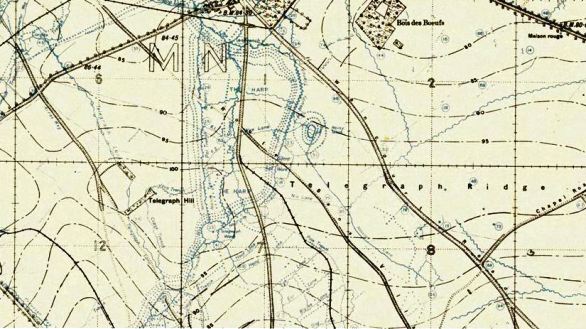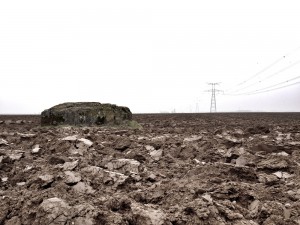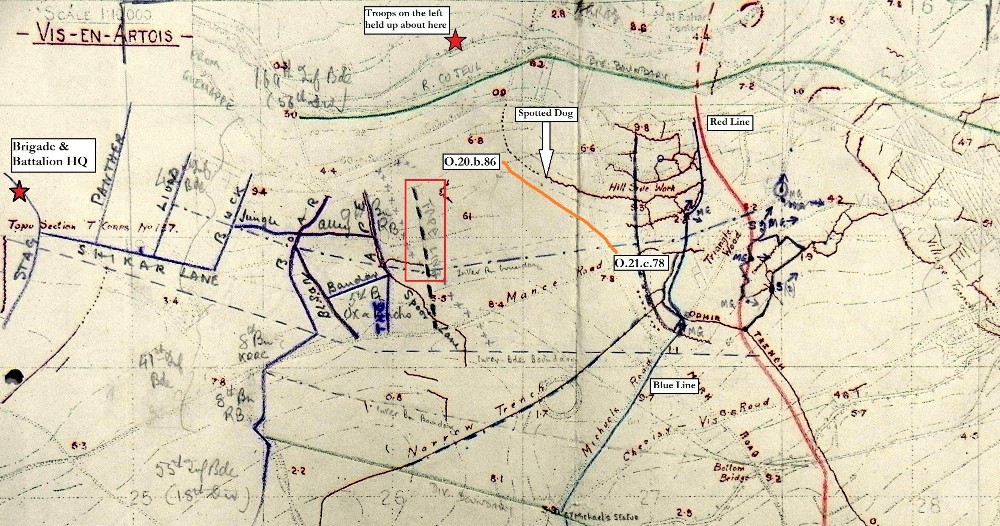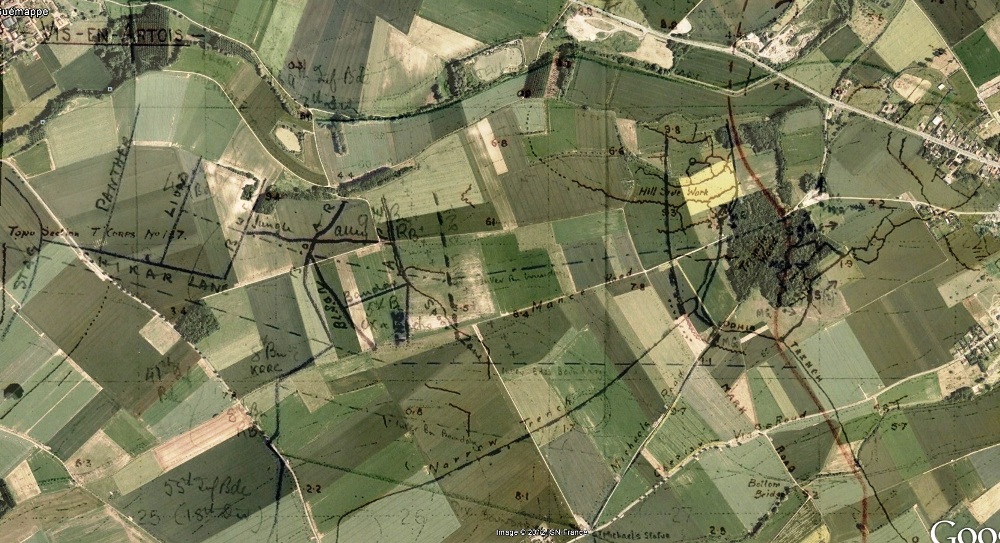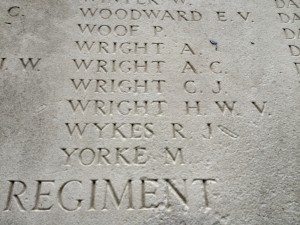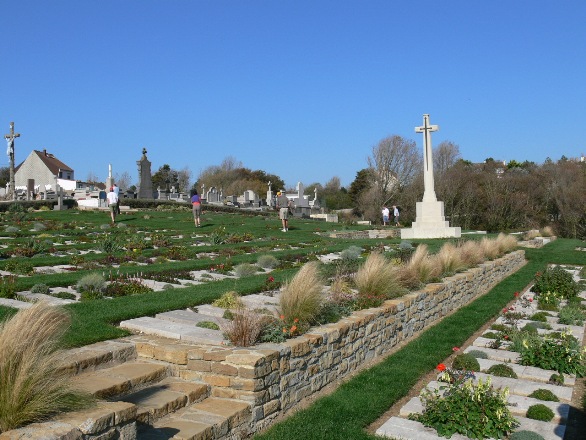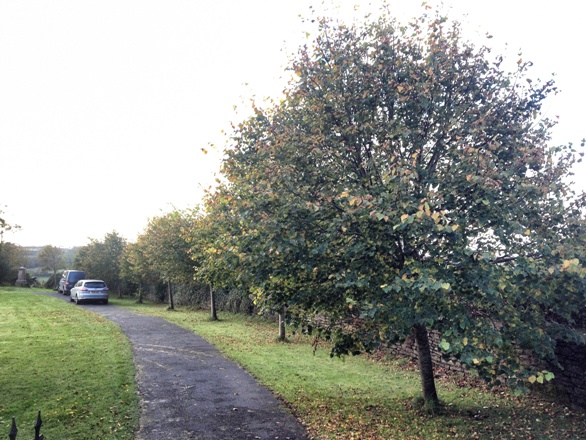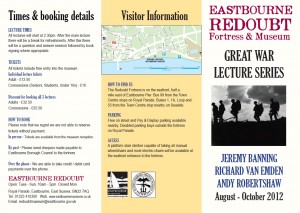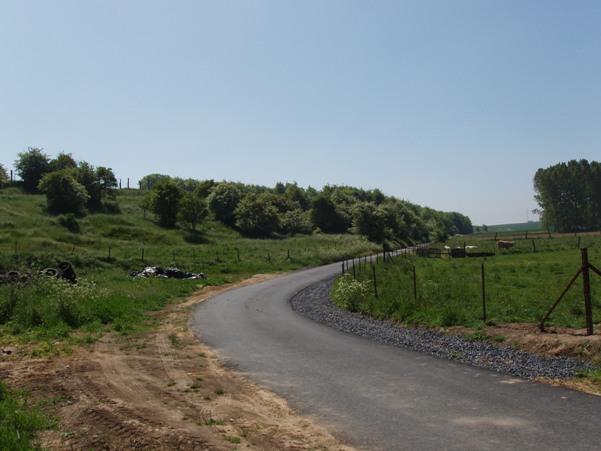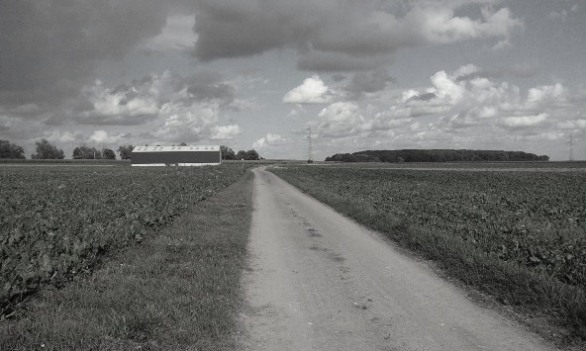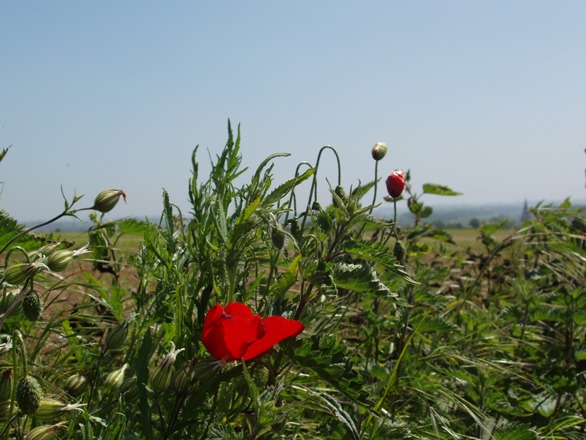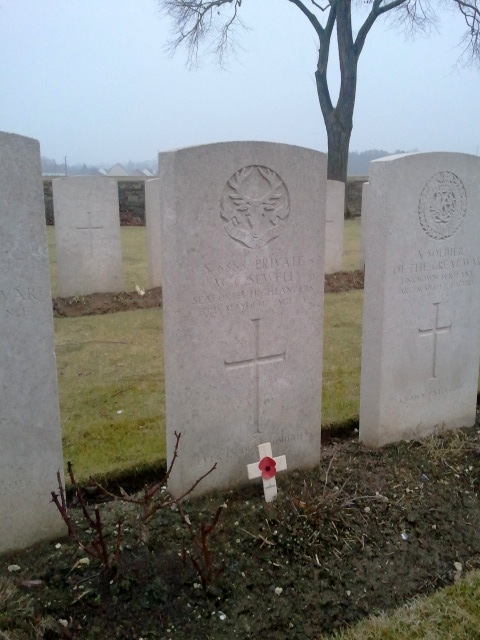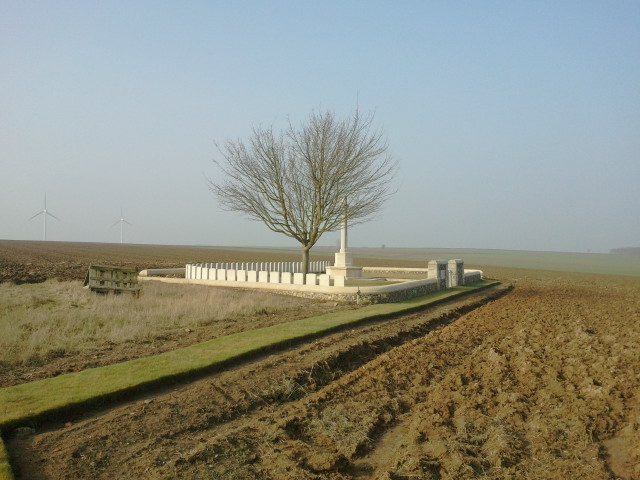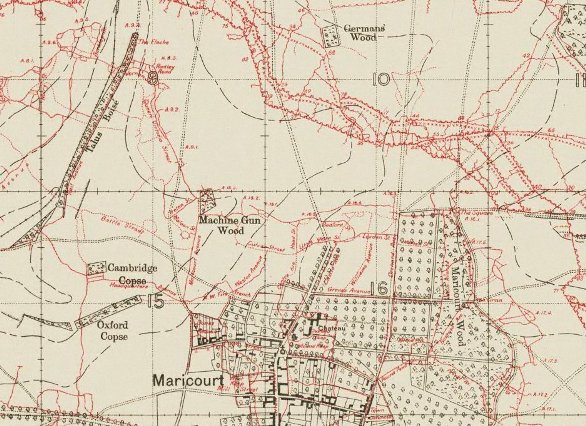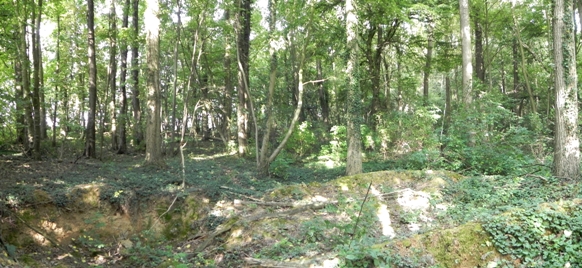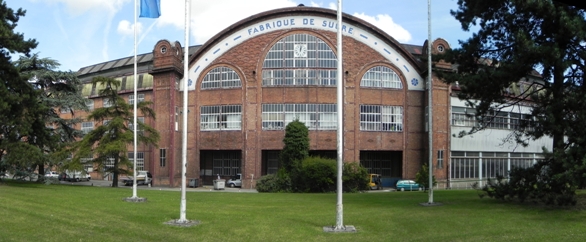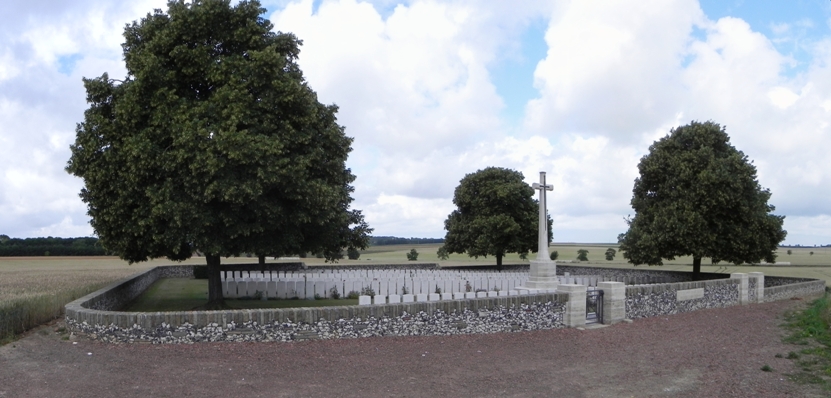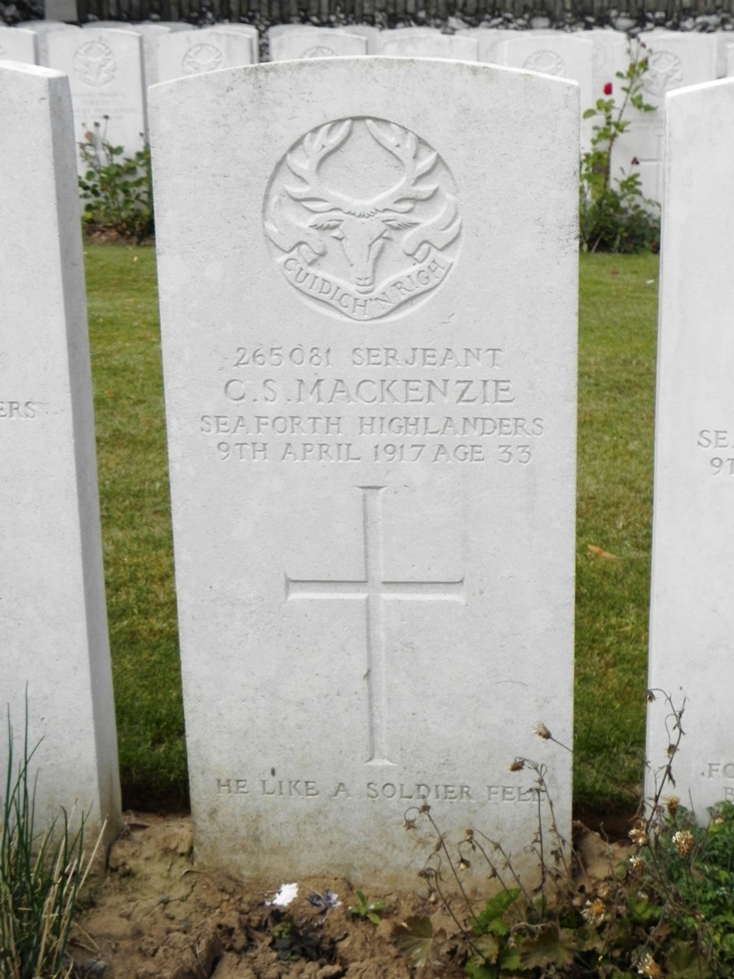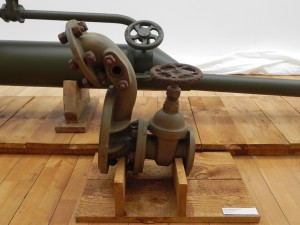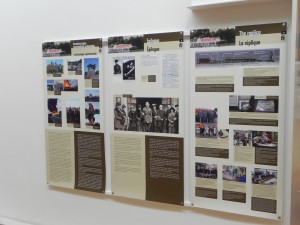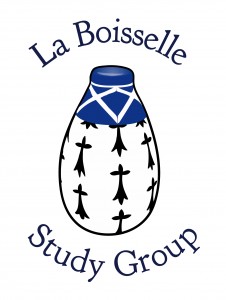Archive for the ‘Research’ Category
Following in the footsteps of the 9th Battalion Rifle Brigade at the Battle of Arras (April – May 1917)
Earlier this month having spent a few days recceing sites and walks for upcoming trips I spent a day showing a client, Tony Wright, around the Arras battlefields following in the footsteps of his great uncle, S/30401 Rifleman Herbert William Victor Wright, 9th Battalion Rifle Brigade who was killed on 3 May 1917. It was most likely that Herbert had joined the battalion as one of nearly four hundred reinforcements received in January 1917. As such, the spring offensive at Arras would be his first major battle.
Sadly, Herbert Wright’s service record no longer existed and so we were unable to determine which company he had served in. However, with the knowledge that he would have been ‘in the area’ we started off by looking at the battalion’s role in the 9 April attack. The 9th Battalion Rifle Brigade was part of 42nd Infantry Brigade, 14th (Light) Division. The divisional objectives for 9 April were to capture the strong German position known as the Siegfried Stellung, (Hindenburg Line) which the Germans had fallen back to throughout the month of March. The hinge of the ‘old’ German line and new Hindenburg Line was the village of Tilloy-lès-Mofflaines. South of the village lay the 14th Division’s objective, the southern part of The Harp, a formidable position some 1000 yards long and 500 yards wide, full of tangled field defences. Along with Telegraph Hill to its immediate south its dominant position enabled German defenders to fire in enfilade northwards up Observation Ridge and southwards to Neuville Vitasse; its capture was absolutely critical.

Looking across the rising ground of The Harp. The 9th Rifle Brigade advanced across here on 9 April 1917
The role of the 9th Rifle Brigade on 9 April was limited to that of ‘moppers-up’. An initial assault was to be made against the southern portion of ‘The String’, a trench running down the length of The Harp, by the 5th Ox and Bucks Light Infantry and 9th King’s Royal Rifle Corps. Once captured the 5th King’s Shropshire Light Infantry would then pass through or ‘leapfrog’ the two battalions to capture the second objective close to the Blue Line running south from the rearward face of The Harp down the Hindenburg Line. Nearly seven hours after the initial advance and with these objectives taken B & D Companies of the 9th Rifle Brigade, under the command of Captain Buckley were to leave their positions in and around the old German front line to clear the ground between the Blue and Green lines within the Brigade boundaries.
They would also occupy an outpost line north east of the Tilloy – Wancourt road (now the D37). Considering the magnitude of the day’s fighting the Battalion war diary gives scant information about the work completed other than to record the final objective was gained by 1.30pm with one hundred prisoners and two machine guns captured. Casualties sustained were Captain D.E. Bradby killed , 2/Lt H.M. Smith wounded and fifteen Other Ranks wounded. Despite differing figures from those provided in Brigade records it is clear that losses amongst the 9th Rifle Brigade were extremely light when compared to other battalions within 42nd Brigade.
After relief on 12 April the Battalion spent time in training where they received a draft of fifty two reinforcements. On 23 April the Battalion began their march back to the battlefield, moving into newly captured positions between Guémappe and Chérisy on the evening of the 24th. The war diary records constant shellfire for this entire period; on one day alone 2/Lt J.M. Harper and a further sixteen Other Ranks were wounded. Between 30 April – 2 May the Battalion were in reserve but provided working parties to dig out a new communication trench named Jungle Alley running between the Ape and the Boar trenches before taking up their positions in the front line north of Chérisy on 2 May. The stage was set for a renewal of the offensive; three armies would be attacking along a fourteen mile frontage from Bullecourt in the south to Fresnoy in the north. Having suffered such comparatively small losses on 9 April the 9th Rifle Brigade was to take a leading part in the coming battle, attacking on the left of the Brigade next to the 5th Ox & Bucks Light Infantry. The 5th King’s Shropshire Light Infantry and 9th King’s Royal Rifle Corps were in Brigade Reserve.
The decision to launch the attack at 3.45am in darkness was contentious. Many commanders protested to no avail. A further complication for the 9th Rifle Brigade was their position nearer to the enemy than neighbouring units. As such, they were not to advance from their jumping off line until eighteen minutes after Zero Hour. The Battalion had two objectives; firstly to capture the Blue Line running in front of Triangle Wood and through Hill Side Work and then to push on to the Red Line, completing the capture of both positions. Advancing from a line 150-200 yards east of the front line marked by white tape fixed to the ground, the Battalion was to advance behind a ‘creeping barrage’ of artillery shells exploding in a slowly moving curtain across the battlefield.
Ten minutes before Zero Hour the first wave left the assembly trenches to line up on the tape. At 4.03pm they advanced, followed by the second wave that left the assembly trenches at Zero +42 minutes. In common with many units who attacked that dreadful day, no further report was ever received from the companies in the first wave. German artillery fire was extraordinarily heavy (lasting for over fifteen hours) with eight company runners either killed or wounded. Post -action reports noted the first wave veered to the right in the darkness, striking a new German trench wired and held by the enemy. Despite this, it was captured by Zero + 40 minutes and advance progressed. However, enfilade machine gun fire caused heavy casualties and ‘few, if any ever reached the rear of Hill Side Work’. All eight officers of the first wave became casualties very early in the day, some being wounded several times. Only seven NCOs of the first wave ever returned. The second wave fared no better. As their advance was in daylight they were subjected to machine gun fire sooner than the first wave and also came up against machine gun positions which had been established after or missed in the dark by the first wave, in addition to enfilade fire from across the Cojeul valley near St Rohart’s Factory.
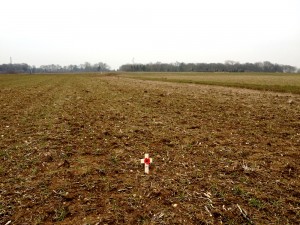
Cross left in memory of Herbert Wright, 9th Rifle Brigade. Triangle Wood and Hill Side Work are on the horizon
The second wave was finally held up just in front of Spotted Dog Trench which was held by the enemy; they dug in along a line of shell holes about 600 to 700 yards in front of their original front line at Ape Trench. A German counter-attack against the 18th Division who had captured Chérisy forced their line back to its starting position; this action rippled northward with orders sent out to recall the Battalion. Such was the dominance of German artillery and machine gun fire (firing continuously from both flanks and from across the river valley) that these orders could only be communicated to two platoons; it being impossible to contact the remnants of the battalion occupying shell holes close to Spotted Dog Trench. On the evening of the 3rd two patrols were sent to recall one company holding a line of shell holes and strong point close to the German trench. Over the next couple of nights survivors of the 9th Rifle Brigade’s attack returned to the original British line. The Battalion’s casualties during the day’s operations were 12 officers and 257 Other Ranks. The 9th Rifle Brigade was relieved on 4 May before heading back to The Harp. This disastrous day marked the beginning of the end of the Battle of Arras. Desperate fighting continued for possession of Roeux, its infamous Chemical Works and Greenland Hill plus around Fresnoy which was recaptured on 8 May. However, by then British attentions were turning northwards to Flanders.
As Herbert Wright’s company is unknown it proved impossible to know whether he formed part of the first or second wave of attackers. Tony and I we walked the attack, passing the assembly trench positions, taped line from which the battalion advanced before moving to the final positions reached. It was here that Tony laid a small poppy cross in memory of his great uncle. Herbert Wright was one of ninety seven men of the Battalion killed on 3 May; all but two are commemorated on the Arras Memorial to the Missing. We visited the Arras Memorial and saw Herbert Wright’s name on Panel 9.
His remains may be buried in the grave of an unknown soldier or still be out on the battlefield. The Third Battle of the Scarpe, as the fighting over 3/4 May was named, was an unmitigated disaster for the British Army which suffered nearly 6,000 men killed for little material gain.
In the Official History, Military Operations France and Belgium 1917 Cyril Falls gives the following reasons for the failure on 3 May 1917 in the VII Corps frontage:
“The confusion caused by the darkness; the speed with which the German artillery opened fire; the manner in which it concentrated upon the British infantry, almost neglecting the artillery; the intensity of its fire, the heaviest that many an experienced soldier had ever witnessed, seemingly unchecked by British counter-battery fire and lasting almost without slackening for fifteen hours; the readiness with which the German infantry yielded to the first assault and the energy of its counter-attack; and, it must be added, the bewilderment of the British infantry on finding itself in the open and its inability to withstand any resolute counter-attack.”
This stark paragraph illustrates perfectly the battlefield during the 3 May 1917 fighting; nightmarish, terrifying and bloody. Having been at home for a week now I am still thinking about it and the windswept ridge between Guémappe and Vis-en-Artois.
“I spent an extraordinary day with Jeremy walking in the footsteps of my Great Uncle, who fell on May 3rd 1917 at the Battle of Arras. He did a wonderful job of balancing a very good explanation of the complexities of the overall battle itself with a highly emotional and personal end to the day of literally experiencing his final hours. As my Great Uncle was a private soldier, without detailed records of his service easily available, I was deeply impressed by how he brought together a range of different sources to nevertheless give me a really specific and personal understanding of what he and his comrades went through. It was an absolutely unforgettable experience”. Tony Wright
A good write up of the part played by one young officer, 2/Lt William Clarke Wheatley, former pupil at Sandbach School who was killed in the 3rd May attack can be found on Conor Reeves’ excellent website: http://sommejr.wordpress.com/william-clark-wheatley-3517/.
Private William Fry, 53rd Battalion AIF at Fromelles for BBC Wales ‘Coming Home’ with Robert Glenister
In October I was approached by Yellow Duck Productions to help with an episode of their BBC Wales series ‘Coming Home’. I was to conduct research into the wartime service of William Fry, a miner from Penclawdd in the north of the Gower Peninsula outside Swansea. William Fry was a relative of Spooks and Hustle actor Robert Glenister.
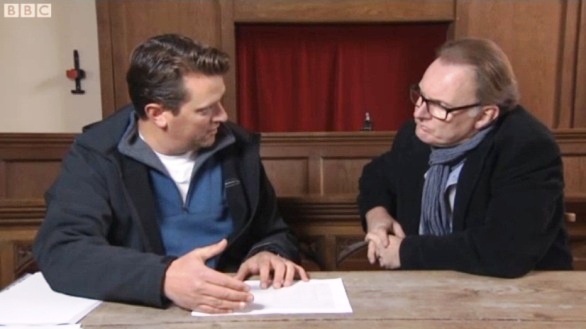
Talking through William Fry's wartime service with Robert Glenister in St Gwynour's Church, Penclawdd
William Fry left Wales in 1914, en route to a new life in Australia. At sea when war was declared, he arrived in Sydney in late August 1914. By the end of July 1915 William had enlisted in the Australian Imperial Force and sailed from Sydney on 8 October 1915 bound for Egypt. Whilst at Tel el-Kebir in February 1916 he transferred to the 53rd Battalion, a strange mix of Gallipoli veterans from the 1st Battalion and new, inexperienced reinforcements from Australia. The battalion, along with the 54th, 55th and 56th formed the 14th Infantry Brigade, part of the Fifth Australian Division.
The battalion arrived in Marseille at the end of June and after a journey north through France entered front line trenches opposite Fromelles on 10 July. It was customary practice to provide new units with time to ‘bed in’ in a quiet, nursery sector in order to get used to the routines and peculiarities of trench life. No such luxury was afforded William’s 53rd Battalion as, within a week, they were selected to be at the vanguard of a strong attack against German trenches at Fromelles. After a day’s rest in billets the 53rd Battalion were back in the front line on 17 July.
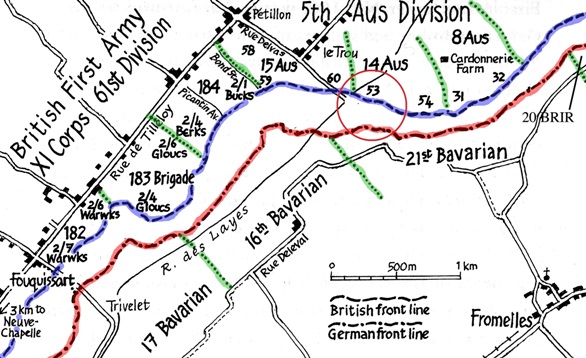
Map showing frontage for the Fromelles attack. The position of William Fry’s 53rd Battalion AIF is circled.
The plan required an initial softening of German defences by artillery bombardment and the attacking infantry to advance at 1800hrs in broad daylight, capturing and seizing two lines of trenches. At 1743hrs the first wave moved out into No Man’s Land, followed 100 yards later by the next wave. At Zero Hour (1800hrs) the Battalion charged and captured the first two lines of trenches as planned but then, contrary to the agreed plan, pushed on ‘200 yds further to hold back enemy’s bomber who were counter-attacking’.
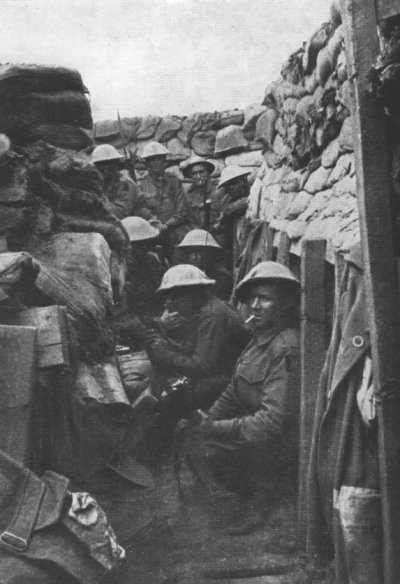
Members of William Fry’s 53rd Battalion prior to ‘hopping the bags’ on 19 July 1916. Reproduced courtesy Australian War Memorial (ID Number A03042).
The positions were held through the night but determined German counter attacks coupled with an exposed right flank forced the 53rd back across No Man’s Land to their starting position at 0930hrs on the 20th. Casualties for the operation totalled 625, an extraordinarily high figure which included the commanding officer. The attack at Fromelles was a complete disaster; losses for the Fifth Australian Division were over 5500 men. At some point on the 19th July William Fry was badly wounded; his medical records show he received GSW (Gun Shot Wounds) to both legs. He was evacuated along the casualty clearance chain, ending up at No.14 General Hospital at Wimereux on the channel coast. Sadly, William Fry died of his wounds at 4.15pm on 26 July 1916 and is buried at Wimereux Communal Cemetery.
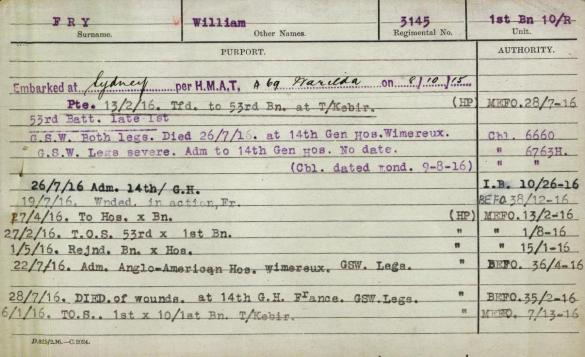
Extract from William Fry’s service record showing his movements from leaving Sydney in October 1915 to his wounding on 19 July and death at No.14 General Hospital, Wimereux.
Prior to the day’s filming at St Gwynour’s Church in Penclawdd Robert was completely unaware of this part of his family’s history. Using the Battalion war diary and maps I was able to talk through William’s service and the 53rd Battalion’s attack on Fromelles. In many ways it was a typical example of the global scale of the war. A miner, all 5ft 2 ¼ inches of him, seeking a new life in Australia but enlisting for King and Country and travelling all the way back to Europe to do ‘his bit’. Fromelles was an ill-conceived diversion against tactically superior German forces but this should not detract from the endeavour, patriotism or simply a longing for involvement in the war of William Fry and his mates in the 53rd Battalion AIF. It was especially poignant leaving the church and walking up the path to my car. It is lined with lime trees – replacements for the original trees planted in the 1920s to commemorate local men lost in the war.
Robert Glenister gave an interview to Wales Online about his participation in ‘Coming Home’: http://www.walesonline.co.uk/showbiz-and-lifestyle/television-in-wales/2012/12/08/hustle-star-robert-glenister-on-his-welsh-ancestor-s-wartime-heroism-91466-32377072/
 Last January I spent three days filming with Hugh Dennis for Wall to Wall’s ‘Who Do You Think You Are?’ series. I see that the BBC have just added a preview on their website with Hugh explaining his interest in his family’s Great War service.
Last January I spent three days filming with Hugh Dennis for Wall to Wall’s ‘Who Do You Think You Are?’ series. I see that the BBC have just added a preview on their website with Hugh explaining his interest in his family’s Great War service.
The episode is to be shown at 9pm on BBC One on Wednesday 12 September. N.B. A full write up of Godfrey Hinnels and his Great War service can now be read here: https://jeremybanning.co.uk/2012/09/12/following-in-the-footsteps-of-godfrey-hinnels-with-hugh-dennis-for-who-do-you-think-you-are/
On Saturday 18 August I will be the first speaker of the Eastbourne Redoubt Fortress & Museum Great War lecture series. My lecture “Somme Archaeology: The Glory Hole and the work of the La Boisselle Study Group” begins at 2.30pm. Ticket prices are £12.50 (Adult) with a concession price of £10 for Senior Citizens, Students and Under 16s.
Further details can be found here: http://www.eastbournemuseums.co.uk/Events.htm
Other speakers for September and October are my good friend Richard van Emden and Curator of the RLC Museum, Andy Robertshaw.
The lecture will showcase the work undertaken since June 2011, giving a history of French, German and British warfare (surface and subterranean) at La Boisselle from 1914-1916. I will also include many images previously unseen showing British tunnels dug in September-October 1915.
A pdf document with details of all three talks can be downloaded by clicking on the image below.
Having just returned from three days in Arras where I gave a lecture at the Carrière Wellington about the Battle of Arras (April-May 1917) I am heartened by the increase in interest shown in the spring offensive. There is even a plan to tweet updates from the battle which should appeal to those using social media. I thought it a good opportunity to write a short article on the first stage of the battle – the First Battle of the Scarpe which ran from 9 – 14 April 1917. If time and work permits I will do the same for the Second (23/24 April) and Third (3 May) Battles of the Scarpe.
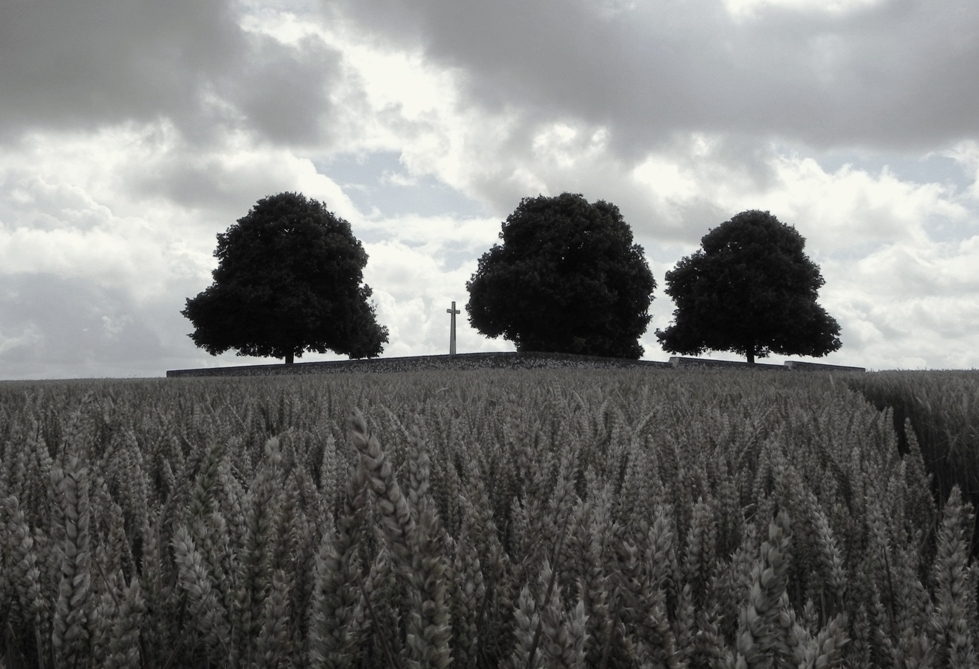
The view from the British trenches at Roclincourt. Highland Cemetery now sits on the position of the German front line. The line was assaulted on the morning of 9 April 1917 by units from the 51st (Highland) Division.
Introduction
Easter Monday, 9 April 1917 was a momentous day which saw the start of the Battle of Arras. It is best known in Canada for the attack and capture by all four Canadian Divisions (operating together as the Canadian Corps) of the previously unconquered heights of Vimy Ridge. It must be remembered that this action, whilst quite rightly lauded was undertaken to protect the northern flank of the main Arras battle front. Sadly, and almost inexplicably the main effort by troops of General Sir Edmund Allenby’s Third Army have been largely neglected by historians, television documentary producers and British battlefield visitors who all head north to Flanders and the blood-soaked fields around Ypres or south to the Somme. I cannot understand this omission as to me, Arras is the most interesting battle of the war offering a major element in the evolution of warfare. By the end of the offensive I would argue that, to many, the prospect of a final victory almost disappears from the Allies’ view.
The British attacks at Arras were part of a larger Anglo-French offensive planned for spring 1917. The author of this scheme was General Robert Nivelle, commander-in-chief of the French armies on the Western Front, who proposed three separate attacks. Two of these astride the Rivers Aisne and Oise would be French led. Great Britain, as the junior partner in the alliance was to launch a major diversionary attack in the north around Arras. It was not what Sir Douglas Haig, commander-in-chief of the British forces wanted, but faced with such a huge French effort there was no other choice but to accept. The German retreat to the pre-prepared positions of the Hindenburg Line (Siegfried Stellung) rendered the attack on the Oise redundant. However, the major offensive on the Aisne and the British diversion at Arras would still go ahead as planned.
9 April 1917 – the opening day
Easter Monday, 9 April 1917 was, in the main, a great success for the attacking British and Canadian forces. Despite the unseasonal sleet, snow and severe cold the Canadian Corps captured the vast majority of Vimy Ridge and British advances to the south were also impressive. An advance of over three and a half miles was achieved by the 9th (Scottish) Division and the ‘leapfrogging’ 4th Division who captured the village of Fampoux. This advance was the longest made in a single day by any belligerent from static trenches.
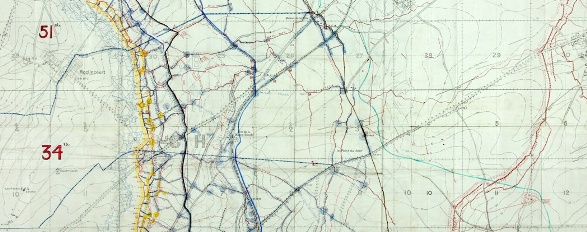
An extract from XVII Corps battle plan showing objectives for the 34th Division including the Point du Jour. Ref: WO153/225. Copyright National Archives & reproduced with their permission.
South of the river attacking British divisions also fared well with Observation Ridge and Battery Valley captured. However, the planned capture of the village of Monchy-le-Preux on its hilltop plateau and Guémappe were not realised. Moving south of the Arras-Cambrai road the successful capture of The Harp and Telegraph Hill can also be viewed as particular triumphs. However, south of the Roman road the British were now attacking the newly constructed Siegfried Stellung (known to the British as the Hindenburg Line). The intelligent siting and design of the Hindenburg Line, coupled with the inability of British artillery to destroy barbed wire sufficiently made the attacks in the south a costlier and much more difficult task. Neuville Vitasse was captured but the two divisions to the south of the village suffered grievously in their attacks.
The night of 9 April saw Germany’s fate in the balance. If British success could be exploited then it was very possible a potentially disastrous breach in their line could lead to a full-scale German retreat. Sadly, for the British, the success of 9 April was the zenith of their action at Arras. Disorganization, breakdown of communications, dreadful weather and the perennial problem of moving the artillery forward over heavily bombarded ground resulted in little concentrated action taking place on 10 April. This delay was exactly what the Germans needed – time to reorganize and strengthen their defences.
First Battle of Bullecourt
The next day, 11 April was a pivotal day of fighting. General Sir Hubert Gough’s Fifth Army attacked in the south at Bullecourt. The hastily constructed plan has been to use tanks of the Heavy Branch Machine Gun Corps to crush the thick belts of barbed wire protecting the Hindenburg Line. When these failed to arrive on time Australian troops broke through the wire, fighting their way into the Hindenburg Line. By midday they were faced with the Germans closing in on them on three sides and were forced to retreat across No Man’s Land to their own line. Over 2,000 men were taken prisoner – the largest number of Australians captured in the war.
The Capture of Monchy-le-Preux
The day also saw the capture of Monchy-le-Preux by the infantry of the 15th and 37th Divisions, aided by six tanks. The capture of the village was an unbelievable feat of arms. Astonishingly, many of the attackers had lain out in the cold and snow for two days and it is a credit to their training and the fighting determination of the British Army that their attacks were pressed with such resilience. Despite the undoubted success of the infantry it is the the fate of the cavalry that Monchy has become synonymous with. With the village captured the cavalry were to advance east to the Green Line. However, they were forced back into the village by German machine gun fire where they were subjected to a ‘box barrage’ of artillery. Unable to escape, the narrow streets were clogged with horses and cavalrymen. The latter dismounted; seeking refuge in cellars but the horses could do nothing and were killed in great numbers as shells rained down. The streets of Monchy, full of horse carcasses and the foul residue of high explosive shells and animals are said to have run with blood.
Disaster for the Seaforths
An ominous taste of things for the future conduct of the battle to come was the attack by the 4th Division on the Green Line from Fampoux. At midday the 2nd Seaforth Highlanders and 1st Royal Irish Fusiliers attacked from the sunken lane between Fampoux and Gavrelle . They were spotted whilst forming up by the enemy in Roeux and on the railway embankment and subjected to shellfire. At zero hour, as they advanced over a kilometre of open ground behind a feeble artillery barrage they were hit by heavy machine gun fire from the railway embankment and Chemical Works. The Seaforths attacked with 12 officers and 420 men and suffered casualties of all 12 officers and 363 men. Only 57 men survived this attack unwounded. This action and the casualties from other battalions of Seaforths are commemorated with the Seaforths Cross at Fampoux. Subsequent attacks were similarly costly. Roeux was fast earning a reputation as a fortress village. British attacks were badly planned and not supported by sufficient artillery fire whilst German defences grew in strength.
13 April was a day for fresh troops to take the field in order to carry on the attack. Exhausted and frozen men trudged back to Arras, replaced by units at full strength. By now it was almost definitely too late for the breakthrough that had appeared so possible on the evening of 9 April.
Infantry Hill – the destruction of the Essex Regiment & Newfoundlanders
An attack was planned from the precarious Monchy salient. Just two battalions of men would attack up Hill 100 (named Infantry Hill by the British). Conditions were so bad in the village with the detritus from horse carcasses blocking the narrow roads that the attack was postponed until 5.30 a.m. on 14 April. The plan was to capture Infantry Hill and send out patrols into the Bois du Sart and Bois du Vert to check for enemy. In hindsight this badly planned attack appears highly dangerous, almost suicidal. The Monchy salient was already surrounded on three sides by enemy forces. The attack, carried out by the 1st Essex Regiment and Newfoundland Regiment went in as prescribed. It started well and by 7.00 a.m. it was reported that Infantry Hill had been captured. However, in their first proper use of the new defensive employment of ‘elastic defence’ a German counter attack was delivered with such speed and precision that over 1000 Essex and Newfoundlanders were killed, wounded or taken prisoner. Monchy had been left undefended and was now at the mercy of advancing Germans troops. The situation was only saved by the commander of the Newfoundland Regiment, Colonel James Forbes Robertson who, with eight other men opened rifle fire from the edge of the village. For five hours their fire held back the enemy until fresh troops reached them. These men, known as the ‘Men who saved Monchy’ were all decorated for this action.
It is not the purpose of this brief article to mention every stage of the fighting but to merely pick out some of the more well-known points. Fighting continued on the Wancourt Ridge with the British capture of the remains of Wancourt Tower. Bitter fighting also continued in the Hindenburg Line; the most well-known casualty from these actions was war poet and officer on the 2nd Royal Welsh Fusiliers, Siegfried Sassoon who was wounded on 16 April. With limited piecemeal actions achieving little Sir Douglas Haig now took control, halting these costly and morale damaging attacks until a combined offensive could be made.
This decision marked the end of the first stage of the Arras fighting – the end of the First Battle of the Scarpe. It was now the turn of General Nivelle to launch his attack on the Aisne. After regrouping and with a marked improvement in weather the British attacked again on 23 April – the Second Battle of the Scarpe.
So, on 9 April 2012, ninety-five years after the whistles blew and attack commenced I will be raising a glass to the memory of the men of all nationalities who fought in the battle. Their sacrifice, perseverance and resolution to finish the job are astonishing. My respect grows for them daily. It is up to all of us to ensure that their efforts are not forgotten.
Should you be interested in the Battle of Arras then the book that Peter Barton and I produced, ‘Arras: The Spring 1917 Offensive including Vimy Ridge and Bullecourt’ is still available. I would urge anyone to visit Arras as it is a lovely town with good hotels and restaurants and only an hour’s drive from Calais. The battlefields are quiet and are immensely rewarding to visit. If you have a relative who fought in the battle or are looking for a guide to show you then please contact me. I would be delighted to help.
The Arras Tourist board are running a number of events over April 2012. Details can be found here: http://www.westernfrontassociation.com/attachments/article/2293/Arras_Ceremony_9_April.pdf
From 2 – 4 March I was guiding a private battlefield tour. Late last year I had been asked to compile a report on S/8888 Private William Charles Sewell who served in the 2nd Battalion Seaforth Highlanders. William Sewell went overseas in November 1915, served through the Somme in 1916 and was killed at Roeux during the Battle of Arras on 3 May 1917. As well as compiling a detailed report on William Sewell’s war service I was asked to take his great nephew, Paul Carter with his friends to follow in William’s footsteps from Arras down to the Somme.
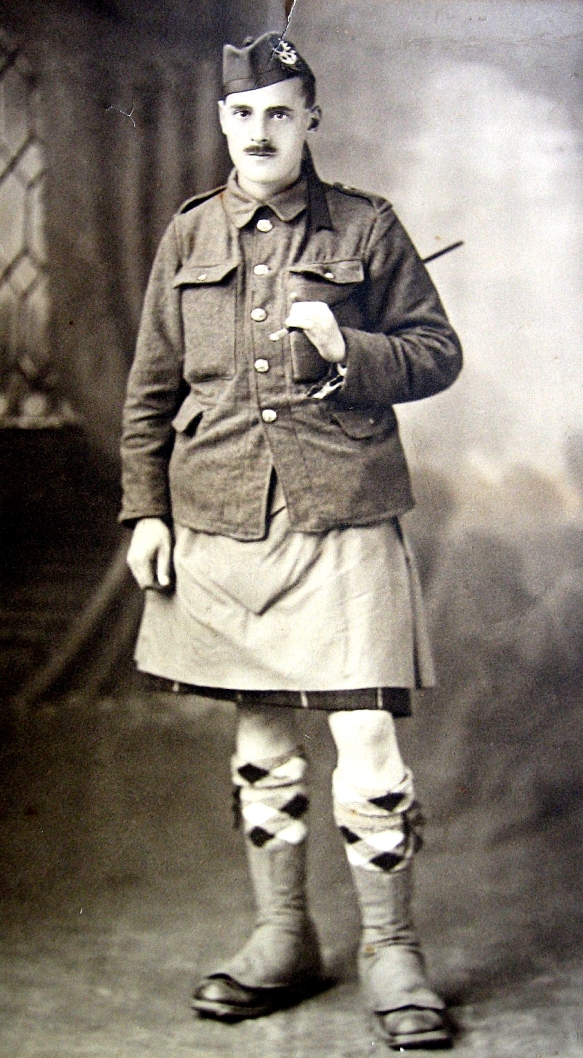
Private William Charles Sewell, 2nd Battalion Seaforth Highlanders. Killed 3 May 1917 during an attack at Roeux during the Battle of Arras. Many thanks to Paul Carter for his permission to use this photo.
Despite a distinct lack of decent weather for the entire trip we had a wonderful time and it was a real honour to be guiding the first member of William Sewell’s family to ever visit his grave. Starting at Vimy Ridge and the Memorial Park we began our tour of the Arras battlefields. After a stop at La Targette for the enormous French and German cemeteries we picked up the Athies road, following in the footsteps of the triumphant 9th (Scottish) Division in their advance on 9 April 1917. After a quick stop at Point du Jour Cemetery and the 9th (Scottish) Division memorial we headed to Fampoux, tracing the route of the 4th Division as they leapfrogged the Scots that day. Stopping at the Seaforths Cross at the Sunken Lane I explained the disastrous attack on 11 April 1917 and read an account of the operation from Private James Stout, a survivor of the attack. As one of those actions that holds a particular fascination for me it was all the more poignant being there with a relative of a soldier who may well have taken place in that ill-planned venture. The following account provides a bleak picture of subsequent events:
At ZERO Hour (12 noon) 2nd Seaforths and 1st Royal Irish Fusiliers advanced, the former on a 3 company front, the latter on a 2 company front. The 2nd Seaforth Highlanders’ objective was the cross roads I.13.a.9.3, exclusive to cross roads I.7.a.4.3 exclusive. Immediately these two battalions advanced, they came under a very heavy machine gun fire from the INN, CHEMICAL WORKS, STATION, CHATEAU and Railway Embankment. The whole ground in Squares H.12 and 18 appeared to be swept by machine gun fire.
At the same time a barrage was put down on FAMPOUX and East of the SUNKEN Road where the remaining two battalions were assembling. This machine gun fire very soon thinned the advancing lines but the troops continued to advance.
On the left, part of a company of the 2nd Seaforth Highlanders entered a new trench some 150 to 200 yards west of the 1st objective, about I.7.c.5.9.
This party under an officer [Lt Donald Mackintosh] maintained itself in the trench for some time, until its ammunition was exhausted, when they were forced back by a counter attack and only a few returned. The remainder, including the officer who is missing, were either killed or wounded, and left in this trench.
The heavy machine gun fire maintained by the enemy made it impossible to obtain information regarding the course of the action but it required no report that a single wave of 400 men who had to advance an average distance of 400 yards with a Battalion front of 1100 yards could not obtain their objectives in face of such machine gun fire and rifle fire.
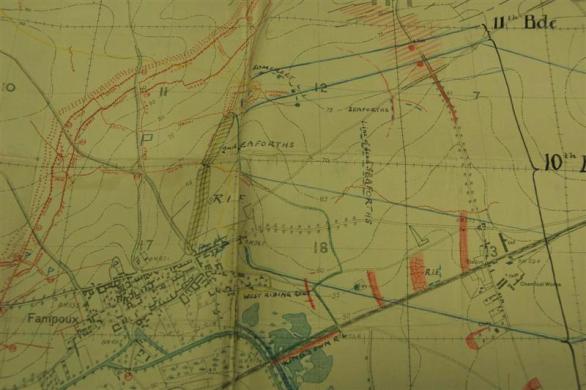
Map extract from 10th Brigade war diary showing 'line of dead Seaforths'. Ref: WO95/1479 10th Infantry Brigade War Diary. Copyright National Archives & reproduced with their permission.
After the debacle of 11 April 4th Division went back for some rest. Their next large-scale attack was the fighting at Roeux on 3 May. It was during this fighting that William Swell was killed. Starting next to the A1 motorway at Crump Trench Cemetery we followed the battalion through their part in the battle. The following map shows the objectives, named respectively the BLACK, BLUE and RED Lines. The total advance was so far as the 4th Division was concerned was to cover a distance of 2500 yards, including:
- The capture of the Northern portion of the village of ROEUX, including the CHEMICAL WORKS and STATION buildings.
- The capture of the trench system on the high ground near HAUSA and DELBAR Woods, and finally
- The piercing of the defences round PLOUVAIN, which were partially wired.
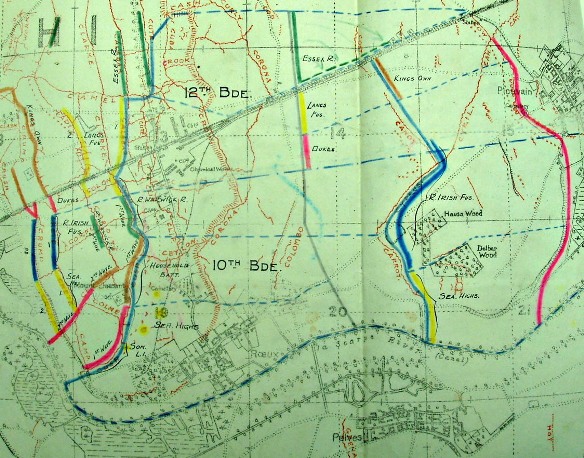
3 May 1917: the 4th Division's attack plan for Roeux . Positions for the 2nd Seaforths can be seen marked in yellow. Ref: WO95/1446 4th Division War Diary. Copyright National Archives & reproduced with their permission.
Of the attack, the war diary notes:
3 May – Zero hour 3.45am when a heavy bombardment of enemy’s position started, lasting for half an hour. Barrage then crept forward very slowly. Battalion left their trenches at 4.30am, being in support to the Household Battalion who were to capture the cemetery north of ROEUX. The Royal Warwickshire Regiment were on the left of the Household Battalion and Royal Irish Fusiliers on left of Seaforths, support to Royal Warwickshire Regiment. 1st Somerset Light Infantry were on the right and were to capture village of ROEUX. On reaching BLUE Line which was just west of DELBAR WOOD the Battalion moved to their right until left of each wave was opposite NW corner of DELBAR WOOD where a halt was made until ZERO + 85 = 5.10am when they advanced to capture the RED line, east of DELBAR and HAUSA WOOD, and immediately west of PLOUVAIN, through I.21.b. and I.15.d & b. This attack unfortunately failed owing to both flanks being held up and severe losses, and later on the whole Brigade line was forced to withdraw to original front line. The Battalion came back to CRETE Trench. This was the position until dark when the Battalion was sent to relieve the Household Battalion in CEYLON Trench from its junction with CORONA Trench I.19.a.8.7. to its junction with COX Trench I.19.a. 7.3. Company Sergeant Major Fraser was in charge of the line as all officers taking part in these operations had become casualties. The Commanding Officer, Adjutant, Medical Officer and three other officers became casualties of the same shell.
Delbar and Hausa Wood no longer exist. Le Lac Bleu (Blue Lake) now covers the ground on which the woods sat. Unless there is specific personal testimony it is notoriously hard to pinpoint the exact spot that a soldier was killed. However, as most casualties were sustained between the BLUE and RED lines it seems likely that William Sewell was killed in this area. Having followed the route of advance we returned to the ground between Fampoux and Roeux to pay our respects at William Sewell’s grave.
Crossing the Scarpe we drove up in Monchy-le-Preux and up Infantry Hill where I recounted the story of 14 April attack by the 1st Essex and Newfoundlanders and the resulting action of the small band of men who saved Monchy from German recapture. For our last stop of the day we headed to the Arras Memorial to Missing.
Next morning began with a windswept walk on the Hindenburg Line to the quiet delight of Rookery Cemetery and Cuckoo Passage Cemetery, the latter full of men of the Manchester Regiment killed on 23 April 1917.
We then headed back into Arras for a good tour of the underground boves and tunnels at Wellington Quarry. Our brief visit to Arras was now at an end as we headed south down to the Somme battlefields.
Our first stop was the Sheffield Memorial Park and the Gospel Copses at Serre (the 2nd Seaforths held the frontline trenches here in November – December 1915). We then headed to Redan Ridge to look at the part played by the 2nd Seaforths in the opening day of the Battle of the Somme, 1 July 1916. The operation plan was for 11th Brigade to take Munich Trench and then for 10th and 12th Brigades to pass through them at a given time and gain the final objective along the Beaucourt Ridge (2nd Seaforths were part of 10th Infantry Brigade)
The war diary offers the following explanation of events:
Zero at 7.30am. From 5.30am the very intense bombardment concentrated on the German trenches in front. At 7.30am the 11th Brigade moved forward from our front in waves.
By 8.45am no messages had come through from 11th Brigade. Patrols advanced and were met by heavy machine gun fire. Telephone to Brigade HQ was out so two orderlies were sent for orders. As they had not arrived by 9am – the hour appointed for the Battalion advance – the remainder of the Battalion moved forward.
On coming into view of the German trenches the Battalion came under heavy machine gun fire from the front and direction of Beaumont Hamel. After passing the German front, parties pushed forward and reached the third line of trenches. Other parties of our men may have reached Munich Trench but there was no possible communication and none returned.
By this time 11th Brigade had already lost their Brigadier, General Prowse (died of wounds) and all four Commanding Officers (killed). Enemy held first, second and third lines on our left and right. Attempts were made to consolidate the ground gained. Enemy bombed on flanks and the third line was given up at about 1pm.
By 11am there were only 5 officers left with the battalion and casualties were proportionately heavy in the ranks. During the evacuation of the third trench Drummer Ritchie sounded the Charge with the idea of encouraging these waverers who had lost their leaders. This gallant action in addition to his conduct throughout the day gained him the Victoria Cross.
We finally withdrew at about 5pm to original front line positions south of the Quadilateral. At this time there were about 40 men of the battalion left.
The war diary records the following casualties:
| Officers | Other Ranks | |
| Killed | 12 | 59 |
| Died of wounds | 1 | 6 |
| Wounded | 8 | 260 |
| Missing, believed killed | 0 | 1 |
| Missing | 0 | 53 |
| TOTAL | 21 | 379 |
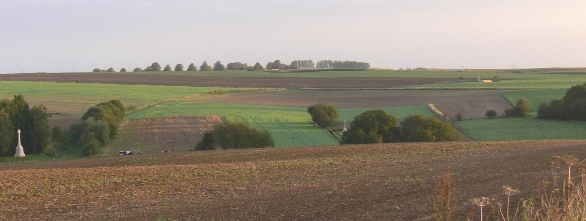
Redan Ridge viewed from a position on the Hawthorn Ridge. The German-held village of Beaumont Hamel is to the right of frame.
Further stops that afternoon included the Sunken Lane at Beaumont Hamel, scene of the infamous attack by 1st Lancashire Fusiliers on 1 July, Newfoundland Memorial Park with its preserved trenches and the Ulster Tower and Thiepval Memorial to the Missing. We finished by following the front line by Authuille Wood to Ovillers, down Mash Valley and then to the hotel at Albert.
Our final day dawned in thick fog which made pointing out sites rather difficult. Beginning with a stop at Fricourt and the Bois Francais we followed the British front line and saw the site of Siegfried Sassoon’s Military Cross action before heading to the site of the Livens Flame Projector site at Mametz. Dropping down to Devonshire Cemetery we headed toward Maricourt and the junction with the French Army on 1 July. Passing Trônes Wood, Guillemont and Ginchy we headed to the desolate fields between Lesboeufs and Le Transloy for our last in-depth look at the part played by the 2nd Seaforths during the Somme battle. Fighting in desperate mud with a thick mist (not unlike the weather on the day we visited) the battalion took place in two attacks in mid-October against German positions in Dewdrop and Rainy Trench. The Battalion war diary recorded the ground conditions in the area:
From Montauban eastwards the whole country is one stretch of absolute desolation – a more gloomy sight I have never seen. The ground is just a maze of shell holes, varying from size of stokes mortar crater to the size of a crater made by a 15-inch.
The attacks on the 14th and 23rd were pressed with utmost gallantry but typical resolute defence from German troops allied to the dreadful ground conditions encountered made any serious advance impossible.
After a walk around Delville Wood and a stop at Flat Iron Copse Cemetery and the Welsh Dragon Memorial at Mametz Wood we ended up at the Glory Hole at La Boisselle where I was able to show them around site and take them underground in W Adit. It had been a real pleasure spending time with these gentlemen. Thanks to Paul Carter and his friends Tim Halliday, Al Kendall and Richard Johnson for making me so welcome. I hope that we can do it again sometime soon – perhaps Ypres next time?
Thank you very much for the wonderful report on my Great Uncle William Sewell and the tailor made trip following in his footsteps 97 years later. Your local knowledge, historical expertise and professional service gave my small group a fantastic tour- better than we could have hoped for. The stories of individual’s personal experiences brought an extra dimension to the trip and brought to life briefly a few of the thousands of names inscribed on memorial walls or grave stones. We all agreed that trip would have been so much less of an event if we had tried to find our own way around, and we would have missed so many significant points. The battlefield overlays and WW1 panoramas were fantastic to relate to as we stood in the centre of all those events and you recounted the events played out. On our journey back there was plenty of talk about the next trip – until then! Paul Carter
I know all four of us found the experience fascinating, thought provoking, educational and frequently moving as well. Your own passion and knowledge of a crucial era in our history was captivating and I am sure like me, the other guys have been singing your praises to those they have talked to about the trip. It certainly was a weekend to remember. Al Kendall
Bespoke battlefield tour walking in the footsteps of Corporal JT Davies VC, 11th South Lancashire Regiment
Earlier this month I spent an enjoyable time on the Somme with a client, Roland Parr, who was following in the footsteps of his great uncle, John Thomas Davies VC, 11th South Lancashire Regiment.
Roland had commissioned me to produce a detailed report on his great uncle in order that other family members could know more about this man, his war and the actions that led to the award of his Victoria Cross. Over the past few months Roland had accompanied me to the National Archives to look at war diaries from Division, Brigade and Battalion level. We also visited the Imperial War Museum to work in the Department of Documents and to have a good look at the new(ish) Lord Ashcroft Gallery which holds the original VC of Jack Davies. It must have been a somewhat surreal experience for Roland to be looking at the actual VC in its hermetically sealed case when he remembers holding the medal as a young boy.
All of this was the precursor to our visit to the battlefields to follow ‘Uncle Jack’ around the western front.
We set out from Peronne and began our pilgrimage at Maricourt, a village that Jack Davies and the rest of the 11th South Lancs would have known well from their time here in 1916. The battalion were the Pioneers to the 30th Division. I had found a map showing the trenches in this sector dug by the battalion during the month of July 1916. I also noted that they had opened out some of the Russian saps dug by men of 183 Tunnelling Company RE. All of these sites could be viewed in the fields in front of us.
We stood at the site of the British front line on the quiet road to Montauban with Machine Gun Wood on our left and Germans’ Wood to our front right and imagined what this scene looked like on 1 July and the subsequent days and weeks as battle moved on in this area.

Panorama from British front line looking towards the village of Montauban on the right hand side - an objective for the 30th Division. Machine Gun Wood can be seen on the left of frame.
After Montauban we stopped at the 18th (Eastern) Division memorial at Trones Wood. The 11th South Lancs had been working in the wood in the latter half of July 1916.
We then spent a pleasant few hours on a tour of the battlefields – all south of the Ancre. Stops included High Wood, Ulster Tower and the Pope’s Nose and the Thiepval Memorial. I was also able to give Roland a good look around the Glory Hole at La Boisselle.
After stocking up on a picnic lunch at the Old Blighty Tea Room at La Boisselle we headed back to Peronne and then down to St Quentin, focussing on the period from the German attack on 21 March 1918 through to the action for which Jack Davies was awarded his VC on the morning of 24 March. We visited the villages of Savy, Roupy and the small site of Epine de Ballon. Jack’s company (unknown) was in one of these locations prior to the German offensive. We then made our way to Fluquieres and from there to the high ground between Aviation Wood and Mill Wood. On the evening of 21 March 1918 the battalion dug and wired a defensive line through here, remaining for nearly 24 hours until on the evening of 22 March the order was given for all troops to withdraw in orderly fashion to Ham. Upon reaching Ham the battalion was told to billet in nearby Eppeville. We had a good look around Ham, visiting the bridge over the Somme Canal blown up by a detachment of Royal Engineers on the morning of the 23rd before driving west to Eppeville itself.

The bridge over the Somme Canal at Ham blown up by a detachment of RE on the morning of the 23 March 1918
This was the village, really no more than one street, intrinsically tied to Jack Davies’s VC story. After stopping at the Sucrerie (ironically now owned by a German company called Südzucker, the largest sugar producer in Europe) we continued west and crossed the railway line, noting the positions held along the line by the battalion.
Finally, we reached the field where two companies of the battalion were almost entirely surrounded on the morning of 24 March 1918. As is the way with so many sights of unimaginable bravery in the Great War there is nothing to mark the site as anywhere special – just a couple of grassy fields next to the road with a man-made lake behind them barring the way to the stream over which the survivors escaped.
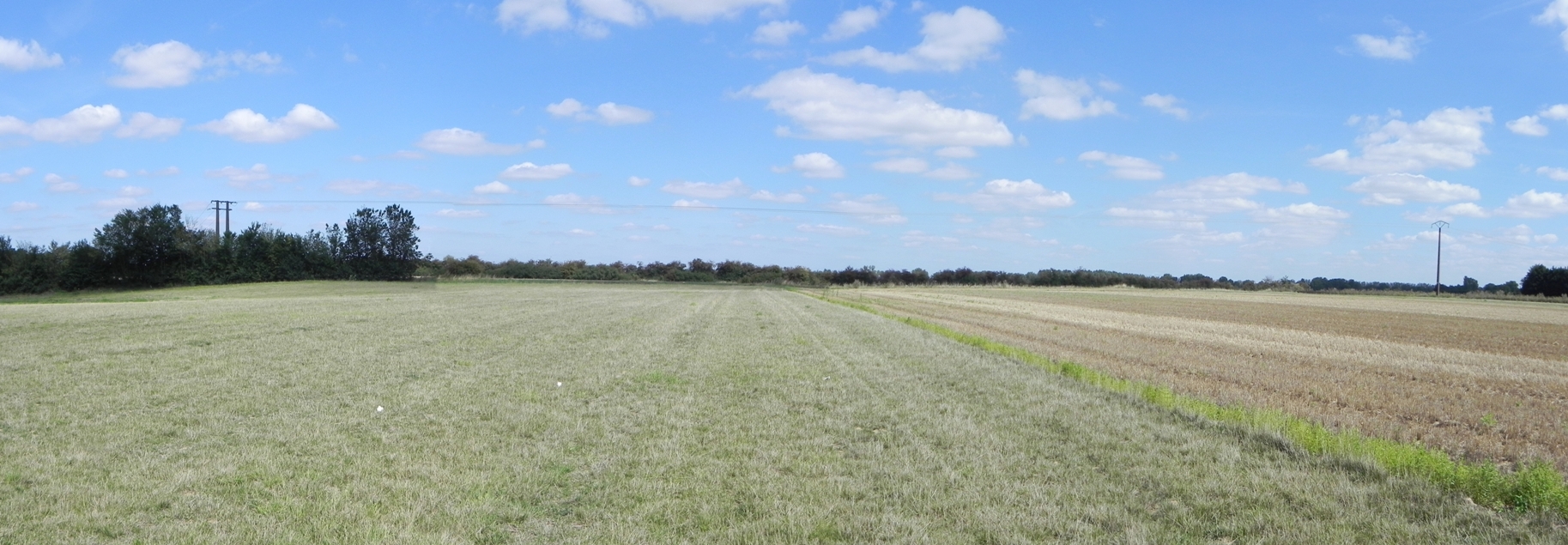
The field where Jack Davies performed the deeds which led to his VC award. German troops had crossed the canal and were coming directly towards this spot.
According to the after-action report compiled in the war diary it was in these two innocuous fields that Jack Davies mounted the parapet and kept his Lewis Gun firing until overwhelmed by the advancing Germans.
For most conspicuous bravery and devotion to duty under heavy rifle and machinegun fire. When his company – outflanked on both sides – received orders to withdraw, Corporal Davies knew that the only line of withdrawal lay through a deep stream lined with a belt of barbed wire, and that it was imperative to hold up the enemy as long as possible.
He mounted the parapet, fully exposing himself, in order to get a more effective field of fire, and kept his Lewis gun in action to the last, causing the enemy many casualties and checking their advance. By his very great devotion to duty he enabled part of his company to get across the river, which they would otherwise have been unable to do, thus undoubtedly saving the lives of many of his comrades. When last seen this gallant N.C.O. was still firing his gun, with the enemy close on the top of him, and was in all probability killed at his gun.
Quite how and why he wasn’t killed remains unknown but it was only two months later, after his VC citation had been published in the London Gazette that word reached home that he was a POW in Germany. It was safely assumed that Jack was killed in the action and so the citation (above) is written as a posthumous record of his bravery.
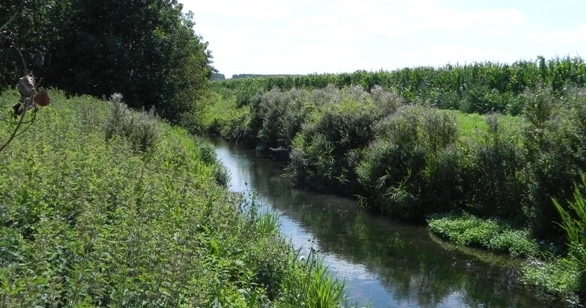
The "deep stream lined with a belt of barbed wire" over which the survivors of the 11th South Lancs escaped - now called the River d'Allemagne.
Roland laid a small cross in the field and we then paid our respects at Ham British Cemetery where other men of the 11th South Lancs who hadn’t the same luck as Jack are buried. It was a spot I hadn’t visited before and I was taken by the two cemeteries – the British and Commonwealth cemetery directly next to the Muille-Villette German Cemetery.

Ham British Cemetery. The black crosses of the neighbouring German cemetery can just be made out above the Portland stone headstones.

A view from the German cemetery - the gravestones of German and British soldiers lie almost side-by-side.
Before leaving I laid a cross at the grave of Lieutenant John Cuthbert Lidgett, 11th South Lancs in memory of all the men of the battalion who made the ultimate sacrifice. It had been a real trip to remember….
“What a wonderful day you provided for me, far exceeding my expectations for our time together. I mentioned the words ‘bringing alive’ and certainly you did that both for the 1 July 1916 action on the Somme and also Jack’s story from 21-24 March 1918. I have no idea how many similar stories you have so far put together, but I cannot think that anyone trying to trace the steps of a long lost relative would regret having made contact with you. If this is the source of your livelihood, then I can see nothing but success ahead.” Roland Parr, Cambridge
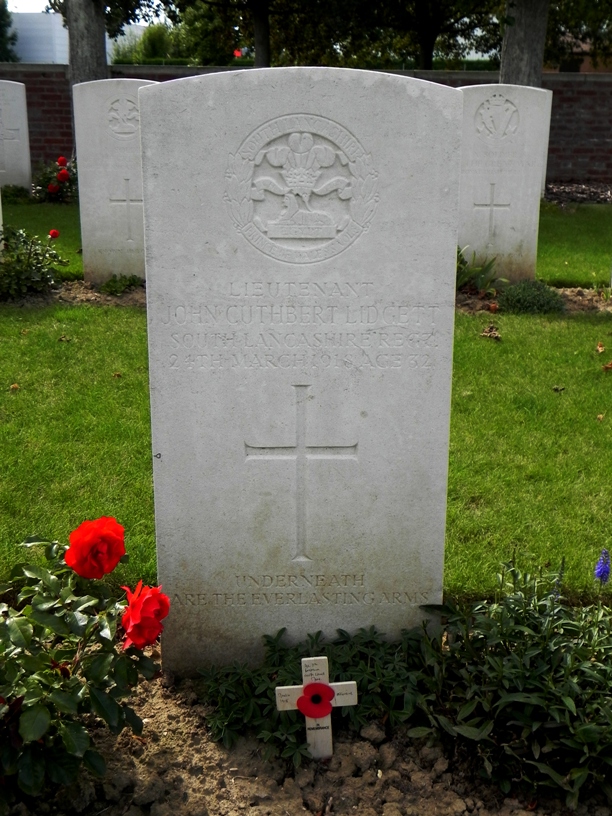
The grave of Lieutenant John Cuthbert Lidgett, 11th South Lancs in Ham British Cemetery. The cross was placed in memory of all the men of the battalion who made the ultimate sacrifice.
What a wonderful day you provided for me, far exceeding my expectations for our time together. I mentioned the words ‘bringing alive’ and certainly you did that both for the 1 July 1916 action on the Somme and also Jack’s story from 21-24 March 1918. I have no idea how many similar stories you have so far put together, but I cannot think that anyone trying to trace the steps of a long lost relative would regret having made contact with you. If this is the source of your livelihood, then I can see nothing but success ahead.
Roland Parr,
Last month I managed to stop in at the Arras battlefields when on my way down to La Boisselle for more site work. I only had a couple of hours before a lunchtime meeting in Peronne but still managed a quick recce for a private battlefield tour I am taking in September.
I have some clients coming from New Zealand who have a relative, Corporal Andrew McDonald MM, who was fatally wounded at the Battle of Arras. I have been compiling a detailed report on this soldier who served in the 6th (Morayshire) Battalion of the Seaforth Highlanders.
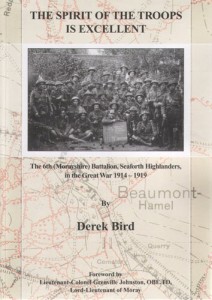
Derek Bird - "The Spirit of the Troops is Excellent." A first-class study of the battalion - highly recommended reading.
Andrew McDonald was in the battalion from its very formation and arrived in France in 1915. As part of 152 Brigade, 51st (Highland) Division he served throughout the Somme offensive including Bazintin-le-Grand, High Wood and the successful capture of Beaumont Hamel in November. He was awarded the Military Medal for his part in a raid on enemy positions in September 1916 on the Railway Salient near Armentieres. A most useful book on the battalion is Derek Bird’s ‘The Spirit of the Troops is Excellent’ which I can heartily recommend as a superb battalion study.
On the opening day of battle, Easter Monday, 9 April 1917 the battalion was to be involved from the off. Facing the German trenches northeast of the small village of Roclincourt they were tasked with capturing three lines of German trenches, the third of which was designed the Black Line. They would then consolidate these whilst the 1/5th Seaforths passed through them in the ‘leap-frog’ system to take the next two lines, the Brown and Blue Lines.
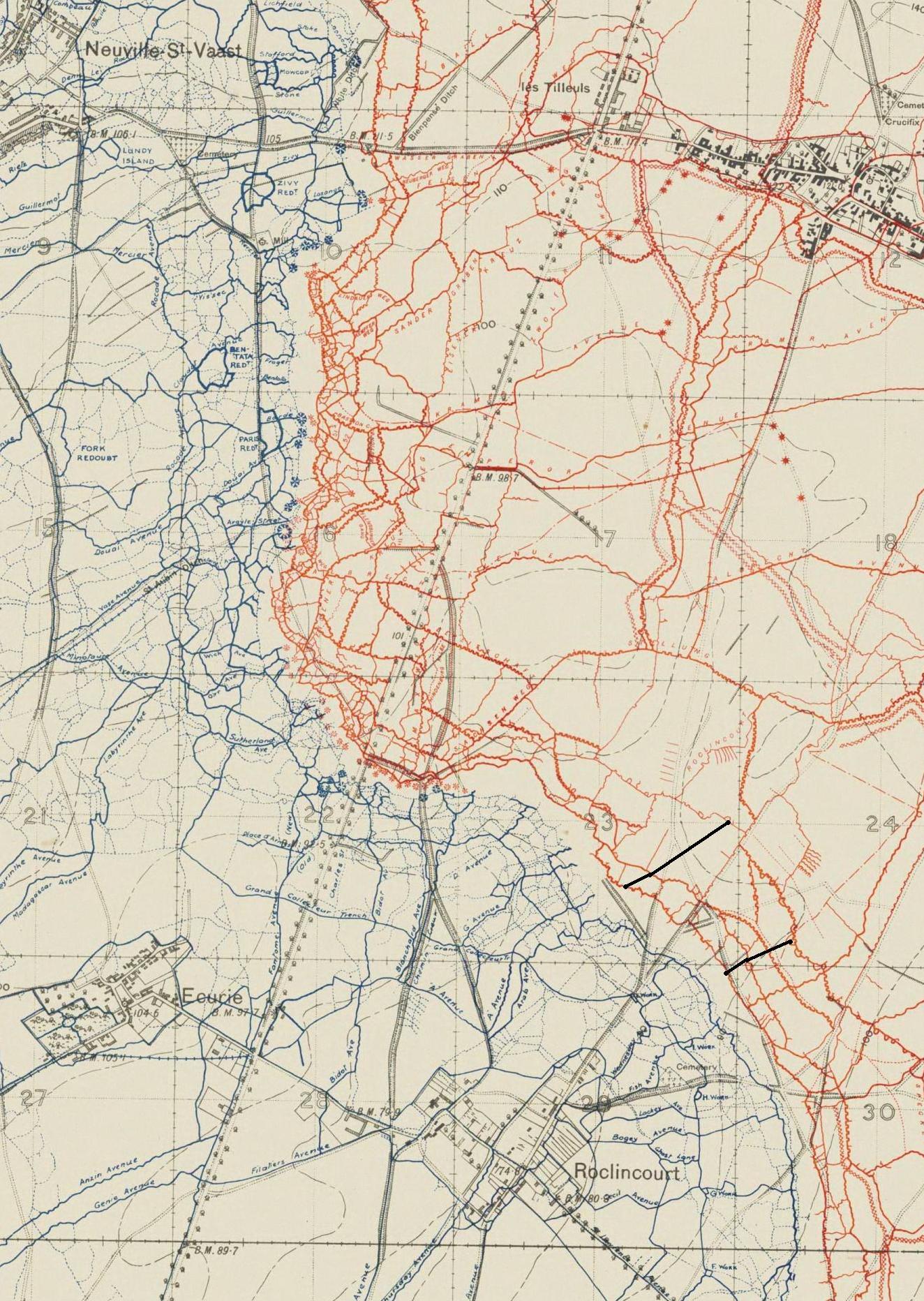
Trench map of Roclincourt-Neuville-Thelus sectors. The black lines are the boundaries for the 6th Seaforths attack on 9 April 1917. CLICK map to enlarge.
Andrew McDonald was serving in C Company – they had even more limited objectives, being tasked with taking and holding a section of the first two lines. D Company with a platoon of B Company would then push on to the Black Line – the final objective for the battalion.
As Andrew McDonald’s service record no longer survives it is very hard to know where he was fatally wounded and the war diary offers scant evidence. However, in September I will take his relatives, having travelled half way around the world, to the site of the jumping-off trenches occupied by C Company and let them stand where he stood on 9 April 1917. I am pretty confident that he was wounded in the fields in front of us, rising towards Farbus and Thélus on the southern shoulder of Vimy Ridge. The beautiful Highland Cemetery now stands close to the site of C Company’s advance. It is full of Highland Division men and is well worth a visit.
One casualty buried in the cemetery that particularly stood out for me whilst reading Derek Bird’s book was Sergeant Charles Mackenzie who was reportedly killed while engaged in a bayonet fight. One of his men was bayoneted and in a selfless act Mackenzie stood over his body to protect him from further wounding. Sadly he himself was then overcome and killed.
Fatally wounded on 9 April Andrew McDonald succumbed to his wounds on 13 April, having made it back to the huge hospitals near Etaples. He is buried in the vast and sobering Etaples Military Cemetery, another spot my clients will visit on their September pilgrimage.

Panorama overlooking Highland Cemetery. It is taken close to the site of the Battalion HQ during the opening stages of the Battle of Arras. The tree lined road on the left takes you to Thelus.
All of this took place just off the A26 motorway so please spare a thought and look to your right and the lonely Highland Cemetery just past Junction 7 next time you are heading south.
Total losses for the Battalion during the opening stages of the Battle of Arras were 9 Officers and 320 Other Ranks. Further trials awaited the battalion later in the month at Roeux and the Chemical Works during some of the most savage infantry fighting of the war. For those with an interest in the battalion Derek Bird has compiled a Roll of Honour to the fallen of the 6th Seaforths. It can be viewed here: http://www.scotlandnorthbranch.webspace.virginmedia.com/Roll-of-Honour/Index.htm
Today sees the public launch of our ambitious project at the Glory Hole in the village of La Boisselle at the heart of the Somme battlefields. We have been invited by the landowners to conduct a long-term archaeological and historical study into the site, one of the most unique still extant on the western front.
BBC Breakfast and News 24 are covering the launch with Robert Hall on live feed from the Somme. He will be interviewing members of the La Boisselle Study Group (Peter Barton, Simon Jones and Iain McHenry) as well as one of the landowners who has given us this tremendous opportunity. Owing to other commitments I am not able to be on site today with my colleagues but am enjoying seeing the reaction in the UK.
For all details of the project please see our website: http://www.laboisselleproject.com/
The detailed article on the BBC website can be read here: http://www.bbc.co.uk/news/magazine-13630203

